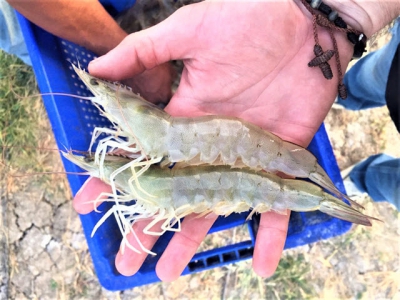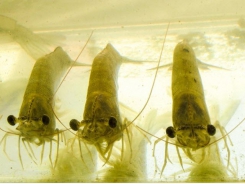GOAL 2019 Global shrimp production review

Projected CAGR of 5.4 percent for 2017 to 2021
GOAL survey respondents reported a surge in production in 2018 (+11 percent, compared to 2017) and expect to see further growth through 2021. Photo by Fernando Huerta.
The Global Aquaculture Alliance’s GOAL (Global Outlook for Aquaculture Leadership) 2019 survey of production trends in shrimp farming polled industry participants in Asia/Oceania (43 responses), Latin America (39 responses) and Africa (two responses). Fig. 1 summarizes the production estimates for global production from 2010 to 2021. The data from 2010 to 2017 represent a mix of FAO (2019) and GOAL survey (2011 to 2018) estimates, whereas 2018 to 2021 data were obtained from the 2019 GOAL survey.
Based on the previous GOAL surveys, the industry showed signs of recovery in 2016 and 2017, resulting in a CAGR of 2.2 percent for the period 2012 to 2017 – much lower than the 6.3 percent rate estimated by the Food and Agriculture Organization of the United Nations (FAO). GOAL respondents reported a surge in production in 2018 (+11 percent compared to 2017) and expect to see further growth through 2021.
It should be noted that the current FAO data for shrimp production in China have been revised downwards every year from 2009 to 2016. The change has shifted China’s shrimp production estimates lower by about 100,000 metric tons (MT) in most of those years. Despite this adjustment, the discrepancy between FAO and GOAL datasets remains, but it is narrower.

Fig. 1: Shrimp farming production by region. Sources: FAO (2019) and GOAL surveys (2011 to 2018) for 2010 to 2017; GOAL survey (2019) for 2018 to 2021.
Asia
According to the GOAL survey, production has recovered since 2015, reaching 3.75 million MT in 2018 and potentially 4.00 million MT in 2021. Growth will be stronger in Vietnam and China, with predicted CAGRs of 4.6 and 3.9 percent from 2018 to 2021, respectively.
Respondents from India and Indonesia expect to see much less growth in their countries: Indonesia expects to produce 450,000 MT in 2021, i.e., 18 percent less than the output reported in 2017. India reached a historic production level of 700,000 MT in 2018 but expects output to fall to 600,000 MT by 2021. Thailand should continue to recover from the impact of AHPND/EMS, albeit at a slow pace: production is expected to reach 330,000 MT in 2021, amounting to only 56 percent of the 2010 (pre-EMS) harvest.

Fig. 2: Shrimp aquaculture production in major farming nations in Asia. Sources: FAO (2019) and GOAL surveys (2011 to 2018) for 2010 to 2017; GOAL survey (2019) for 2018 to 2021.
Latin America
Fig. 3 presents estimates for the major producing nations in Latin America. The most important development in the region is the spectacular growth of the Ecuadorian shrimp farming industry. Ecuador has fully taken advantage of the pervasive disease crisis in Asia to increase exports to European and Asian markets. Production is expected to reach 700,000 MT in 2021, with a CAGR of 11.3 percent between 2015 and 2020. This growth would make Ecuador the third largest producer in the world after China and Vietnam. Ecuador will continue to account for more than half of the farmed shrimp supply in the Western Hemisphere.
Although Mexico withstood severe losses in 2013, the industry was able to restore production by 2015. Further growth is expected, with harvests reaching 180,000 MT in 2021 (CAGR of 10.4 percent during 2015 to 2021). Growth is also predicted in Brazil, with production exceeding 110,000 MT in 2021.
Peru, Venezuela and Guatemala also reported positive expectations for growth through 2021; in contrast, much less growth is expected in Honduras, Nicaragua, Panama and Colombia. Overall, the region produced 920,000 MT in 2018 and expects to reach 1.18 million tons in 2021 (CAGR of 6.5 percent for 2018 to 2021).

Fig. 3: Shrimp aquaculture production in major farming nations in Latin America. Sources: FAO (2019) and GOAL surveys (2011 to 2018) for 2010 to 2017; GOAL survey (2019) for 2018 to 2021.
Product form trends
The GOAL survey also collects information on trends in size categories and product forms. A recent and notable trend in Asia is the increase of green shrimp relative to other product forms such as peeled. While head-on and head-off green shrimp accounted for only 25 percent of production in the 2008 survey, it accounted for 45 percent in the most recent poll. These changes suggest a growing importance of the domestic Chinese market, which has a preference for green shrimp.
Production in Latin America continues to be oriented towards green shrimp. Head-on shrimp has become the dominant product form over head-off shrimp. It accounted for 55 percent of production in 2018, up from 40 percent in 2007. Increased shipments of Ecuadorian shrimp to European and Asian markets are an important factor driving this trend.
Respondents in Asia have reported a move towards production of smaller shrimp sizes (51-60 and smaller) since 2011 (Fig. 4). The share of small counts increased from 27 percent in 2010 to 48 percent in 2017. Early harvests caused by EMS and other diseases is a likely driver of this trend. The share of small counts decreased to 37 percent in the most recent survey, but it remains higher than the small-count shares reported prior to 2011.

Fig. 4: Shrimp aquaculture production in Asia by size categories. Source: GOAL surveys (2008 to 2019).
Issues and challenges
Once again, “diseases” was clearly identified by Asian respondents as the top challenge faced by the industry. “Feed costs” and “access to disease-free broodstock” were ranked as the second- and third-most pressing issues, respectively. “International trade barriers” came close in fourth place (up from eight place in the 2018 survey), probably reflecting increased concerns about the ongoing trade disputes between the United States and China. “Market prices” was ranked as the seventh-most important issue.
In contrast, Latin American respondents singled out “market prices” as the most important issue in shrimp farming, with “feed costs” and “fuel costs” emerging as the second- and third-most pressing issues. “International trade barriers” was ranked fourth (up from the fifth position in the 2018 survey). “Diseases” dropped to seventh place, after being consistently ranked as a top three issue in the most recent years.
The rankings provided by Latin American respondents in the 2019 survey are similar to those reported in the 2007 survey, when producers used to be more concerned about market prices, feed costs and trade barriers as opposed to diseases. Disease management and production practices in the region have apparently calmed fears about emerging pathogens. In Asia, “diseases” clearly remains the most pressing issue given the strong impact of EMS and new, emerging diseases in countries such as India.
On average, Asian respondents tended to be more optimistic than producers from other countries about global economic conditions and the strength of the shrimp market in 2020. Greater agreement was found across countries regarding feed prices, which will continue to experience upward pressure in 2020.
Authors: James L. Anderson, Ph.D. Diego Valderrama, Ph.D. Darryl E. Jory, Ph.D.
Có thể bạn quan tâm
Phần mềm

Phối trộn thức ăn chăn nuôi

Pha dung dịch thủy canh

Định mức cho tôm ăn

Phối trộn phân bón NPK

Xác định tỷ lệ tôm sống

Chuyển đổi đơn vị phân bón

Xác định công suất sục khí

Chuyển đổi đơn vị tôm

Tính diện tích nhà kính

Tính thể tích ao hồ



 Study of co-infection of WSSV and Vibrio parahaemolyticus
Study of co-infection of WSSV and Vibrio parahaemolyticus  Feed formulations affect shrimp flavor, texture
Feed formulations affect shrimp flavor, texture